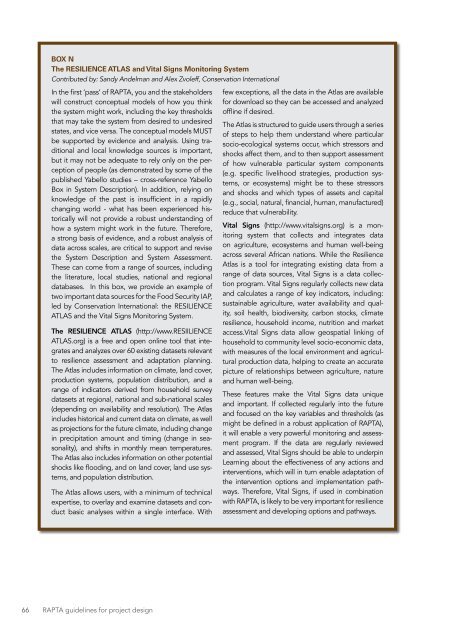DESIGNING PROJECTS IN A RAPIDLY CHANGING WORLD
srun3013fp1
srun3013fp1
Create successful ePaper yourself
Turn your PDF publications into a flip-book with our unique Google optimized e-Paper software.
BOX N<br />
The RESILIENCE ATLAS and Vital Signs Monitoring System<br />
Contributed by: Sandy Andelman and Alex Zvoleff, Conservation International<br />
In the first ‘pass’ of RAPTA, you and the stakeholders<br />
will construct conceptual models of how you think<br />
the system might work, including the key thresholds<br />
that may take the system from desired to undesired<br />
states, and vice versa. The conceptual models MUST<br />
be supported by evidence and analysis. Using traditional<br />
and local knowledge sources is important,<br />
but it may not be adequate to rely only on the perception<br />
of people (as demonstrated by some of the<br />
published Yabello studies – cross-reference Yabello<br />
Box in System Description). In addition, relying on<br />
knowledge of the past is insufficient in a rapidly<br />
changing world - what has been experienced historically<br />
will not provide a robust understanding of<br />
how a system might work in the future. Therefore,<br />
a strong basis of evidence, and a robust analysis of<br />
data across scales, are critical to support and revise<br />
the System Description and System Assessment.<br />
These can come from a range of sources, including<br />
the literature, local studies, national and regional<br />
databases. In this box, we provide an example of<br />
two important data sources for the Food Security IAP,<br />
led by Conservation International: the RESILIENCE<br />
ATLAS and the Vital Signs Monitoring System.<br />
The RESILIENCE ATLAS (http://www.RESIILIENCE<br />
ATLAS.org) is a free and open online tool that integrates<br />
and analyzes over 60 existing datasets relevant<br />
to resilience assessment and adaptation planning.<br />
The Atlas includes information on climate, land cover,<br />
production systems, population distribution, and a<br />
range of indicators derived from household survey<br />
datasets at regional, national and sub-national scales<br />
(depending on availability and resolution). The Atlas<br />
includes historical and current data on climate, as well<br />
as projections for the future climate, including change<br />
in precipitation amount and timing (change in seasonality),<br />
and shifts in monthly mean temperatures.<br />
The Atlas also includes information on other potential<br />
shocks like flooding, and on land cover, land use systems,<br />
and population distribution.<br />
The Atlas allows users, with a minimum of technical<br />
expertise, to overlay and examine datasets and conduct<br />
basic analyses within a single interface. With<br />
few exceptions, all the data in the Atlas are available<br />
for download so they can be accessed and analyzed<br />
offline if desired.<br />
The Atlas is structured to guide users through a series<br />
of steps to help them understand where particular<br />
socio-ecological systems occur, which stressors and<br />
shocks affect them, and to then support assessment<br />
of how vulnerable particular system components<br />
(e.g. specific livelihood strategies, production systems,<br />
or ecosystems) might be to these stressors<br />
and shocks and which types of assets and capital<br />
(e.g., social, natural, financial, human, manufactured)<br />
reduce that vulnerability.<br />
Vital Signs (http://www.vitalsigns.org) is a monitoring<br />
system that collects and integrates data<br />
on agriculture, ecosystems and human well-being<br />
across several African nations. While the Resilience<br />
Atlas is a tool for integrating existing data from a<br />
range of data sources, Vital Signs is a data collection<br />
program. Vital Signs regularly collects new data<br />
and calculates a range of key indicators, including:<br />
sustainable agriculture, water availability and quality,<br />
soil health, biodiversity, carbon stocks, climate<br />
resilience, household income, nutrition and market<br />
access.Vital Signs data allow geospatial linking of<br />
household to community level socio-economic data,<br />
with measures of the local environment and agricultural<br />
production data, helping to create an accurate<br />
picture of relationships between agriculture, nature<br />
and human well-being.<br />
These features make the Vital Signs data unique<br />
and important. If collected regularly into the future<br />
and focused on the key variables and thresholds (as<br />
might be defined in a robust application of RAPTA),<br />
it will enable a very powerful monitoring and assessment<br />
program. If the data are regularly reviewed<br />
and assessed, Vital Signs should be able to underpin<br />
Learning about the effectiveness of any actions and<br />
interventions, which will in turn enable adaptation of<br />
the intervention options and implementation pathways.<br />
Therefore, Vital Signs, if used in combination<br />
with RAPTA, is likely to be very important for resilience<br />
assessment and developing options and pathways.<br />
66 RAPTA guidelines for project design


